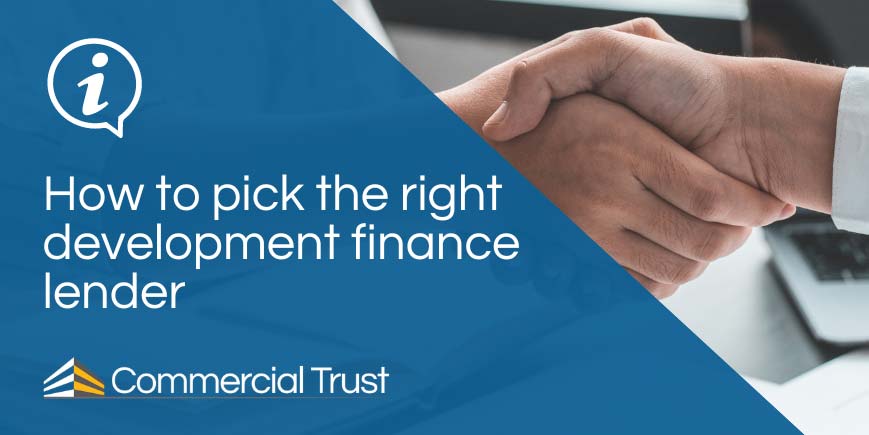This information should not be interpreted as financial, tax or legal advice. Mortgage and loan rates are subject to change.

Categories: guides | development finance guides
Whether you’re an investor looking into ground-up property development, or you’re a house-building entrepreneur looking to go out on your own, this guide discusses what you need to know.
Even if you’re simply curious about ground-up development, and want to learn more about the steps involved in this lucrative branch of property investing, this guide will help.
Content
What is ground-up development?
Ground-up development is a branch of property investing that involves buying a plot of land and building on it, whether that is a house, group of houses, or a commercial property. It is the most risky form of property investing, but can offer significant financial rewards.
A fully built property with plumbing, electrics, insulation, and Wi-Fi, is a lot more valuable than a plot of land – and so the sale of the property, once built to regulatory standard, (less labour and financing costs) should generate a decent profit before tax.
Ground-up development is considered the most risky form of property investing as it requires not only a spread of professional know-how (which you can outsource), but also co-ordination of multiple parties and processes and conducting detailed due diligence, in order to see it through to completion.
There are also factors out of your control that can impact either the profitability, or timescale, of the project.
Costs involved in ground-up development
There are a variety of costs involved with ground-up development that you need to know about.
- Purchasing the land.
- Labour costs (hiring an architect, contractors, electricians, plumbers, etc.).
- Cost of materials.
- Cost of borrowing.
- Fees for submitting planning applications.
This is by no means an exhaustive list, and just provides the main costs most typical with most ground-up development projects.
Exact costs involved are highly dependent on the specifics of each build.
Steps involved in ground-up development
From due diligence and planning, to building then selling - or mortgaging and letting out the property - there is a well-defined progression that developers go through in order to complete a project.
However, it goes without saying that the more complex a project is, the more steps will be involved. The steps below relate mostly to residential builds, however the steps involved will be similar to commercial ground-up development.
Market analysis
Before anything else, you must look at the market. Create a list of the areas you would want to build in, and think about why you would want to build in those areas. Is there adequate demand? Is the cost of buying land competitive?
Once you have a list of the areas you want to invest in, scour the available plots of land in those areas. Which ones have the most potential? Which ones would be easiest to build on?
Look at the wider market as a whole, is land selling at a premium or discount price? Is the cost of borrowing low or high at the moment?
Do your due diligence: Create a budget of all your estimated costs, the cost of materials, land, borrowing, etc.
Regulation
Part of conducting your due diligence is getting to a point where you are comfortable with the regulatory requirements of your project.
A ground-up development will require planning permission, unless it falls under permitted development rights (this typically relates to industrial premises and warehouses). Once you have conducted your due diligence, apply for planning permission.
Applying for planning permission
Learn more about what the UK government needs for a planning application, and apply here.
Purchasing the land
Deciding on which plot of land to buy should be completed in your due diligence stage.
If you’re purchasing land in order to build residential properties, you should pay attention to the residential properties in the surrounding area.
By assessing their market value, you can approximate the market value of the residential units you intend to build.
When purchasing the plot of land it is also important to negotiate the price.
Researching the potential value of the completed project will give you an idea as to whether you are paying a premium or discount price, and indicate whether the seller might be flexible on price, or not.
Once you have secured ground-up development finance, the lender can release ‘day one’ funds to cover a portion of the cost of land.
Secure ground-up development finance
A property developer is presented with two options, whether to source the financing themselves by approaching lenders, or whether they seek the professional guidance of a broker.
However, it should be said there is a real benefit to seeking the professional advice of a broker, as they can save you both time and money.
Picking the right development financing is crucial, and a topic in its own right – that is why we have written comprehensive guides on both scenarios.
Read our guides on:
How to pick the right development finance broker.
How to pick the right development finance lender.
Building the property
Once you have done your due diligence, got planning permission, sourced financing, and purchased the property, you’re ready to put shovels in the ground!
If you have not got the expertise to do this yourself, you will need to hire experienced building contractors to complete the job. They may be able to recommend electricians, plumbers, and other professionals to help get all the works done.
Below is a brief overview of the steps involved in residential ground-up development for one unit:
Step One: Prepare groundwork and set foundation.
Step Two: Fit walls, floors and the roof.
Step Three: Complete plumbing and electrical work.
Step Four: Install insulation.
Step Five: Install interior.
Step Six: Install skirting, doors, patio.
Step Seven: Fit the flooring.
Step Eight: Install bathroom and kitchen fixtures.
Sell or rent to exit the ground-up construction loan
Now that the unit is built, you need to either put it on the market to sell, or advertise it as a rental.
Successfully marketing the property typically involves working with an estate agent. Meet with a few local companies and establish which you think will do the best job for the right price.
If you are selling the property, you could stay on the development finance until you sell, then a part of the proceeds would pay back the loan.
If you’re wanting to rent the property out, you’d switch to a longer-term loan (either a buy to let mortgage or a commercial mortgage depending on the property type).
If you run into trouble completing the work, or the property (ies) take longer to sell than you expected you may be under pressure to repay your development finance loan before you are ready to.
If this is the case, development exit finance is a solution to consider. Rates can be lower than development finance, and it will buy you time while you finish works or wait for the property to sell. You would then pay back the exit finance with a portion of the proceeds.
Things to consider when financing ground-up development
Before you take out development finance, there are a few things to bear in mind.
You will need to provide documents to the lender you choose to go with. Whilst the requirements differ from lender to lender, the most typical documents required for a ground-up development finance application are:
- Evidence of your deposit.
- Evidence of experience with similar projects.
- Evidence of planning permission.
- Valuation of land at time of purchase and a projected value for the project at the time of sale.
- Documentation on construction costs.
- A schedule of works (who will do the work, when, how much it will cost)
You will also need to tell the lender what your exit strategy is. If you are transitioning to long-term finance you may be asked to provide documents evidencing the product you will pay back the development funding with.
This is by no means an exhaustive list, and lender requirements may vary.
How long do you need to borrow funds for?
Before you submit an application for a ground-up development loan, you will need to calculate how long you will need the loan for.
To ensure this is as accurate as possible, plan how much time it will take from purchasing the land to building the property, all the way up to finalising the sale and receiving funds, or refinancing to a mortgage.
It is best to extend the loan term, by a number of months more than you initially think the project will take, as contingency, in case things overrun.
Ground-up development projects can easily overrun their schedule, given their scale, and so it can be a smart move to be generous with your requested loan term.
How many drawdowns will you need?
A ‘drawdown’ is another word for releasing a portion of the loan funds. For ground-up development finance, portions of the total loan will be released as each stage of the development is completed (this is what the schedule of works document is used for). Each release of funds is called a ‘drawdown’.
You will need to keep in mind how many drawdowns you’ll need, as some lenders will set a maximum number.
However, other lenders will allow as many drawdowns as you need, but typically charge an additional fee per drawdown.
Have you got a contingency fund?
It is important to have a contingency fund. This is a portion of additional funds held to the side in case problems emerge that weren’t considered in the budget.
You can include an amount for contingency in the ground-up loan you apply for. Make sure you specify this to the lender before submitting the application.
A contingency fund of 10-15 per cent of the overall cost of the project is common.
Commercial Trust is a ground-up development finance broker
No matter the scale of your project, the specialist advisors at Commercial Trust can provide you with tailored support.
Contact us using the number displayed at the top of this page.
Alternatively, talk directly with our advisors through our live chat feature.
If you prefer a call back, simply request one here





